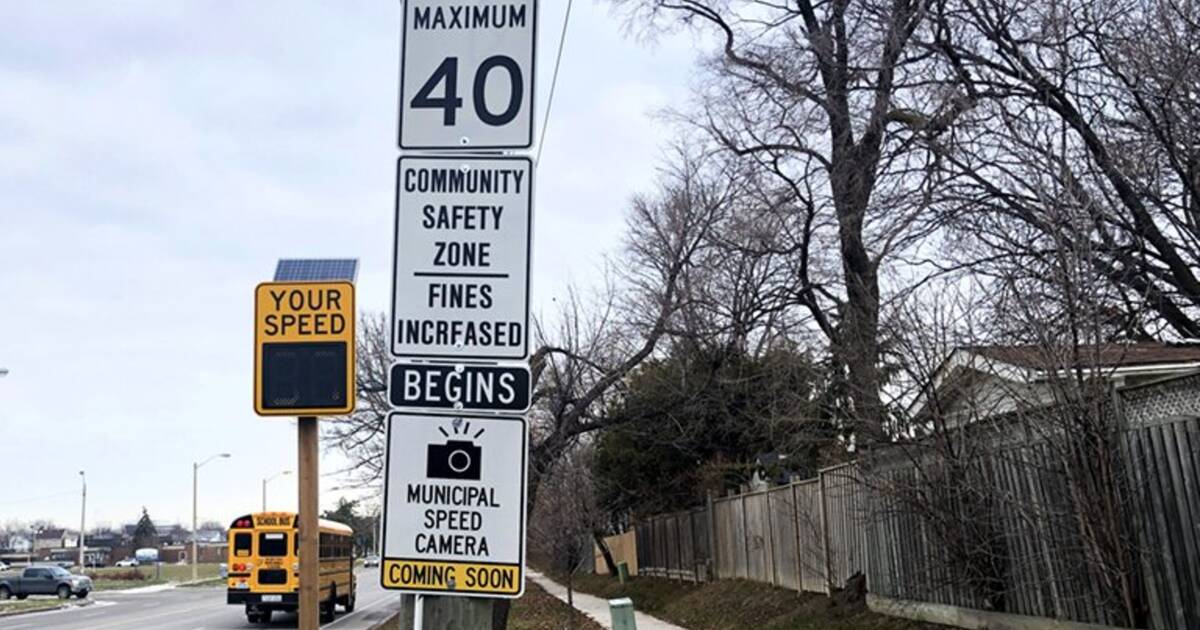
Toronto Mayor John Tory announced today that the city's Automated Speed Enforcement (ASE) program will begin issuing tickets to speeding drivers on Monday, July 6.
ASE cameras were first installed in various locations around the city roughly six months ago, and there are now a total of 50 cameras installed on local, collector and arterial roads in Community Safety Zones near schools.
Automated Speed Enforcement tickets will be issued to owners of speeding vehicles starting Monday, July 6. For more information on the program, fines, penalties and locations, please visit https://t.co/oDiUnzyxB9. #VisionZero
— TO Transportation (@TO_Transport) June 26, 2020
News Release: https://t.co/nMmoLw1a3G pic.twitter.com/ysYBk5NIrH
Ticketing was originally scheduled to start in April, but was eventually delayed due to the COVID-19 shutdown.
The news comes as speeding and stunt driving have been on the rise over the past few months, especially as roads turned quieter amid the pandemic lockdown.
Toronto has had an "epidemic" of speeding during the pandemic Tory says, more than 142K vehicles were clocked speeding at just 9 of the sites during the period. Below some of the examples of the speeding that, if done now, would trigger big tickets pic.twitter.com/QlzJZpuVGy
— David Rider (@dmrider) June 26, 2020
And before the temporary suspension of the program, in the months of February and March alone, Transportation Services staff issued more than 25,000 warning letters to drivers for speeding in ASE locations, according to a city release.
The release states that starting July 6, if a vehicle is detected travelling in excess of the posted speed limit in an ASE-enforced area, the registered owner of the vehicle will receive a ticket regardless of who was driving.
Starting July 6, the City’s 50 Automated Speed Enforcement (ASE) cameras will start ticketing drivers who are caught travelling in excess of the posted speed limit. ASE is one of the many tools in our #VisionZero toolbox intended to reduce speeding in our city and save lives. pic.twitter.com/BveMRpTSUH
— John Tory (@JohnTory) June 26, 2020
"The total payable fine amount includes a set fine, which is determined by Schedule D under the Provincial Offences Act, a proportional victim fine surcharge and applicable court costs. Offenders are only fined – demerit points will not be applied," notes the release.
Anyone caught speeding between one and 19 km/h over the posted speed limit will receive a set fine of $5 per kilometre, while drivers caught travelling between 20 and 29 km/h over the posted speed limit will receive a set fine of $7.50 per kilometre.
The set fine will be $12 per kilometre for anything between 30 and 49 km/h over the limit.
"For example, if a vehicle is detected speeding 49 km/h over the posted speed limit, the total payable fine amount would be $718. This includes a set fine of $588, a victim surcharge of $125 and $5 in applicable court costs," reads the release.
And for anyone caught speeding 50 km/h or more over the posted speed limit, a summons will be issued to the registered vehicle owner to appear before a Justice of the Peace and they will not be eligible for settlement outside of court.
Each ward has two ASE cameras that will capture and record images of vehicles travelling in excess of the posted speed limit. Signage is installed in advance of all ASE locations so that motorists are aware of their presence.
— City of Toronto (@cityoftoronto) June 26, 2020
The city release notes that ASE camera locations were selected based on where speed and collisions have been a problem in Community Safety Zones near schools, and planned road work, speed limit changes, obstructions or impediments to the equipment, boulevard space and the nature of the road were also taken into consideration.
Toronto city council has long endorsed the use of ASE cameras to enforce the rules of the road, and the province of Ontario approved regulations to allow municipalities to operate automated speed enforcement programs back in December of 2019.
Signage was put up in advance of camera installations so motorists were aware of their presence.
More information on the City’s Automated Speed Enforcement program and a map of all locations is available at https://t.co/u3Pnhw6vM8
— City of Toronto (@cityoftoronto) June 26, 2020
"We have fought long and hard for the provincial permission and regulations to be able to use this technology to help protect pedestrians and crack down on speeding in our neighbourhoods," said Tory in the release.
"Automated Speed Enforcement is one example of the data-driven actions we are taking to achieve our Vision Zero road safety goals. This is about making our roads safer and saving lives. I'm confident the program will help slow drivers down in zones where children and older adults are likely to travel."
by Mira Miller via blogTO

No comments:
Post a Comment